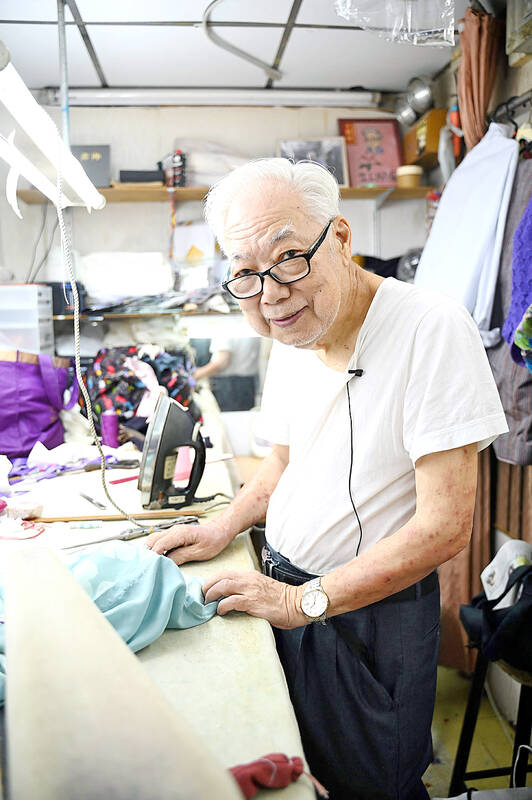Bent over a magenta chiffon fabric, an elderly Hong Kong tailor wearing thick glasses meticulously stitched on embroidered butterflies, working to transform the shimmering material into an elegant, high-collared Chinese dress known as a cheongsam.
Aged 88, Yan Kar-man (殷家萬) is one of Hong Kong’s oldest master tailors of the cheongsam — literally “long clothes” in Cantonese — a dress recognizable for its form-fitting silhouette which was famously featured in Wong Kar-wai’s film In the Mood for Love.
Experts say the silver-haired tailor is among about 10 remaining makers of cheongsam in Hong Kong, which in the mid-1960s used to have about 1,000, according to records from the Shanghai Tailoring Workers General Union.

Photo: AFP
However, after dressing generations of women ranging from housewives to movie stars like Michelle Yeoh (楊紫瓊) and Shu Qi (舒淇), Yan has decided to hang up his measuring tape soon — by the end of this month at the earliest.
“I can’t see clearly — my eyes are not working well, and neither am I. I have to retire,” he said as he stooped closer to his sewing machine to tack on an embroidered border on the dress.
With about 10 more dresses to finish, Yan hesitated to give an exact closing day for his tiny workshop located in the bustling Hong Kong commercial district of Jordan.

Photo: AFP
Evolved from the long robes worn by Manchurian people in China’s Qing Dynasty, the cheongsam has dominated the wardrobes of ordinary Chinese women for much of the 20th century since it was popularized in Shanghai in the 1920s.
Its high-neck collars, knee-length slits and streamlined fits evoked a sense of city glamour, and by the 1960s the dress was everywhere in Hong Kong.
“Women would wear them to shop in wet markets,” recalled Yan, whose workshop walls are plastered with photos of beauty pageant queens wearing his dresses.
Some of his celebrity customers have even reached out for major life events — like Liza Wang (汪明荃), a Hong Kong diva nicknamed “Big Sister” in entertainment circles, who has been his client for three decades.
“I didn’t know it was for her wedding when I made her a dress with one of her scarves and turned the scraps into a tie for her groom,” Yan said.
Born in Jiangsu Province, China, north of Shanghai, Yan was 13 when his uncle brought him to Hong Kong in 1949 to work as an apprentice in a workshop, where the school dropout was discovered to be a young talent.
At that time, the trade for cheongsam was so common and stable that Yan recalled a plain design would cost “just a few [Hong Kong] dollars.”
Western fashion became popular after World War II, and the rise of the garment manufacturing sector in Hong Kong squeezed the cheongsam out of the fashion limelight while pushing tailoring workshops out of business.
Today, the traditional technique to make the dress is “critically endangered,” said Brenda Li, an adviser to the Hong Kong Cheongsam Association.
“Hong Kong’s cheongsam-making has developed its own style and tradition in the past century, merging skills of dimensional cutting from the West,” she said.
“Few people still wear and care about it, but we want to preserve it no matter how niche it has become because it’s part of our culture,” she added.
Although cheongsam-making technique has been recognized as part of Hong Kong and China’s cultural heritage, Yan said the withered trade offers little chance to pass on his craft.
“You can’t make a living by making qipao because it’s no longer the trend,” Yan said, using the Mandarin word for the dress.
The master — who also teaches at a learning center near his shop — said his students were “far from ready to make real clothes for clients.”
Nowadays, orders typically come from older women who need a statement dress to attend their children’s weddings, and each piece takes Yan weeks to finish and costs several thousand Hong Kong dollars.
“How many old clients are still out there, and how many pieces of such detailed work can you make every month?” Yan asked rhetorically. “My generation is mostly gone.”

POLITICAL PRISONERS VS DEPORTEES: Venezuela’s prosecutor’s office slammed the call by El Salvador’s leader, accusing him of crimes against humanity Salvadoran President Nayib Bukele on Sunday proposed carrying out a prisoner swap with Venezuela, suggesting he would exchange Venezuelan deportees from the US his government has kept imprisoned for what he called “political prisoners” in Venezuela. In a post on X, directed at Venezuelan President Nicolas Maduro, Bukele listed off a number of family members of high-level opposition figures in Venezuela, journalists and activists detained during the South American government’s electoral crackdown last year. “The only reason they are imprisoned is for having opposed you and your electoral fraud,” he wrote to Maduro. “However, I want to propose a humanitarian agreement that

ECONOMIC WORRIES: The ruling PAP faces voters amid concerns that the city-state faces the possibility of a recession and job losses amid Washington’s tariffs Singapore yesterday finalized contestants for its general election on Saturday next week, with the ruling People’s Action Party (PAP) fielding 32 new candidates in the biggest refresh of the party that has ruled the city-state since independence in 1965. The move follows a pledge by Singaporean Prime Minister Lawrence Wong (黃循財), who took office last year and assumed the PAP leadership, to “bring in new blood, new ideas and new energy” to steer the country of 6 million people. His latest shake-up beats that of predecessors Lee Hsien Loong (李顯龍) and Goh Chok Tong (吳作棟), who replaced 24 and 11 politicians respectively

Young women standing idly around a park in Tokyo’s west suggest that a giant statue of Godzilla is not the only attraction for a record number of foreign tourists. Their faces lit by the cold glow of their phones, the women lining Okubo Park are evidence that sex tourism has developed as a dark flipside to the bustling Kabukicho nightlife district. Increasing numbers of foreign men are flocking to the area after seeing videos on social media. One of the women said that the area near Kabukicho, where Godzilla rumbles and belches smoke atop a cinema, has become a “real

‘WATER WARFARE’: A Pakistani official called India’s suspension of a 65-year-old treaty on the sharing of waters from the Indus River ‘a cowardly, illegal move’ Pakistan yesterday canceled visas for Indian nationals, closed its airspace for all Indian-owned or operated airlines, and suspended all trade with India, including to and from any third country. The retaliatory measures follow India’s decision to suspend visas for Pakistani nationals in the aftermath of a deadly attack by shooters in Kashmir that killed 26 people, mostly tourists. The rare attack on civilians shocked and outraged India and prompted calls for action against their country’s archenemy, Pakistan. New Delhi did not publicly produce evidence connecting the attack to its neighbor, but said it had “cross-border” links to Pakistan. Pakistan denied any connection to